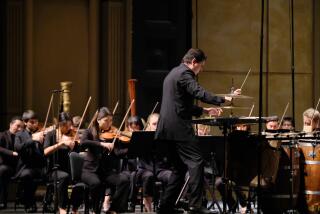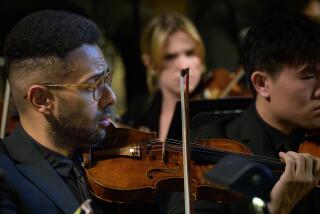Pacific Faces Cuts in NEA, Private Funds
The Pacific Symphony has taken a one-two punch in the money belt, thanks to the steep reduction of a key corporate gift and a federal grant just half the size of last year’s.
Mervyn’s California, which has subsidized the orchestra’s Saturday family concerts with $40,000 for each of the past five years, will “significantly” cut that amount next year, Mervyn’s spokeswoman Carol Johnson said Thursday.
The company’s grant pool has shrunk 37% due to a 52% drop in company profits, Johnson said.
Orchestra Executive Director Louis G. Spisto said he expects to get no more than $10,000 from the department-store chain next year. In any case, Spisto said, the family concerts series, which has been subsidized by Mervyn’s to some extent since 1982, will continue. Starting next season, however, Spisto said, the series, previously known as “Mervyn’s Musical Mornings,” will no longer bear the company’s name.
Replacement funds already are being sought from individuals and a private foundation Spisto declined to name. Those are the the same sources the orchestra will look to to offset its reduced 1996 grant from the National Endowment for the Arts, which is down by about 50% to $31,200.
Congress slashed the NEA’s 1996 budget by 39% to $99.5 million. Spisto said he had expected less from that agency this year.
“But it’s frustrating,” he said, “because as we [expand] programs, we are trying to [expand] funding, not simply replace lost funding.” This year, the orchestra increased its classical music series from nine to 10 pairs of concerts. It will use the NEA grant mainly for artists’ fees.
Likewise, South Coast Repertory received a reduced NEA grant this year, $50,000 compared to about twice that last year. SCR producing artistic-director David Emmes also had been expecting less this year, “so the fact that we did receive some support we took as something of a positive sign.”
SCR will use its NEA money for a new play program and will seek donations from patrons and businesses to make up the lost revenue, said Emmes, who doesn’t expect to have to cut any programs. He and Spisto agreed, however, that the continuing decline of corporate and government arts support means the increased reliance on private sector benevolence won’t let up.
“What this means, very clearly,” Spisto said, “is that we’re going to need to rely more heavily upon individuals and specifically individuals from this community.”
More to Read
The biggest entertainment stories
Get our big stories about Hollywood, film, television, music, arts, culture and more right in your inbox as soon as they publish.
You may occasionally receive promotional content from the Los Angeles Times.










